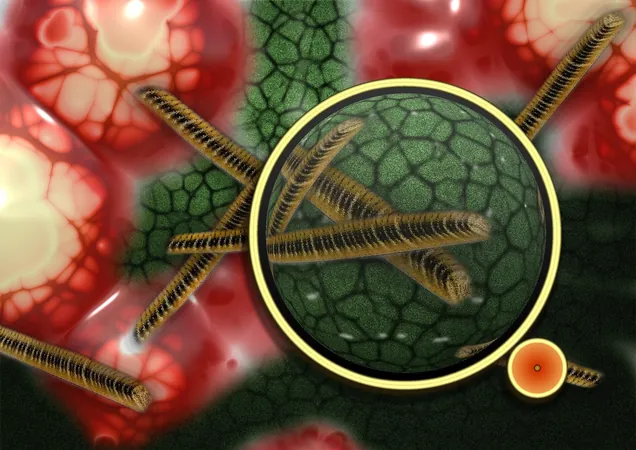
Unveiling the Ancient Secrets of Bacterial Evolution: A Trillion Species and 3 Billion Years of History with AI!
2025-04-05
Author: Mei
Science has long grappled with the staggering diversity of life on Earth, estimated to comprise around one trillion species of microorganisms, most of which are bacteria. These microscopic entities are single-celled and lack the complex structures that larger animals possess, making it challenging for scientists to trace their evolutionary timelines through traditional geological records.
In a groundbreaking study published in the journal Science, researchers have harnessed the power of artificial intelligence (AI) to illuminate the hidden pathways of bacterial evolution. This innovative approach not only reveals intricate details about how bacteria adapted to their environments but also uncovers the fascinating timeline of their evolution, pushing back the boundaries of what we previously understood.
The Birth of the Earth and the Dawn of Life
Around 4.5 billion years ago, a catastrophic collision with a Mars-sized object resulted in the formation of the Moon and potentially wiped out any existing form of life on the newly formed Earth. Following this violent event, single-celled microbes emerged as the dominant life forms. For about 80% of Earth's history, these microorganisms reigned supreme, forming the bedrock for all subsequent biological diversity.
In the words of evolutionary biologist Theodosius Dobzhansky, "Nothing in biology makes sense except in the light of evolution." And yet, the exact processes shaping early life remain elusive, particularly due to bacteria's unassuming nature.
Tracing Evolution Through DNA and Machine Learning
To better understand the evolutionary connections among different species, scientists leverage molecular techniques to compare DNA sequences. Such analyses have shown surprising relationships; for instance, humans share a closer genetic link to mushrooms than to apple trees! However, traditional DNA comparisons fall short when it comes to pinpointing the timeline of evolutionary events.
Enter the Great Oxidation Event, approximately 2.4 billion years ago—a threshold moment when the Earth's atmosphere transformed due to the rise of cyanobacteria and their groundbreaking invention: photosynthesis. This process not only allowed these bacteria to harness solar energy but also released oxygen as a byproduct, leading to dramatic shifts in Earth’s atmospheric composition.
A Double-Edged Sword
Oxygen brought forth a new era for life, but it also posed a grave threat to many anaerobic organisms that were unprepared for the sudden influx of this noxious gas. The resulting mass extinction forced surviving bacteria to either adapt to the new oxygen-rich environment or retreat into the Earth’s depths, where oxygen was not a factor.
A Leap into AI-Powered Discovery
By integrating geological data and employing machine learning techniques, researchers have constructed a refined timeline of bacterial evolution, utilizing the Great Oxidation Event as a benchmark or "fossil" calibration point. By training AI models to identify whether specific bacterial genes indicated oxygen use, scientists could predict ancient bacteria's metabolic behaviors with remarkable accuracy.
A Shocking Revelation
The results presented a provocative twist: some bacterial lineages capable of oxygen metabolism existed a staggering 900 million years prior to the Great Oxidation Event. This indicates that evolutionary adaptations to oxygen occurred even in conditions where atmospheric oxygen was not freely available. Intriguingly, findings also suggest that cyanobacteria likely developed the ability to use oxygen before mastering photosynthesis itself.
Implications for Understanding Life on Earth
This research not only reshapes our comprehension of bacterial evolution but also sheds light on how these life forms adapted and thrived in the face of Earth's dynamic environments. As we continue to explore the intersection of ancient microbiology and modern technology, we can expect even more astonishing insights into the complexities of life that have emerged over the past billions of years.
With the journey of bacterial evolution now partially illuminated, one can only wonder what other secrets the microscopic world still holds—especially as we chart the course for a future where AI and biology intertwine, potentially revolutionizing our understanding of life itself.


 Brasil (PT)
Brasil (PT)
 Canada (EN)
Canada (EN)
 Chile (ES)
Chile (ES)
 Česko (CS)
Česko (CS)
 대한민국 (KO)
대한민국 (KO)
 España (ES)
España (ES)
 France (FR)
France (FR)
 Hong Kong (EN)
Hong Kong (EN)
 Italia (IT)
Italia (IT)
 日本 (JA)
日本 (JA)
 Magyarország (HU)
Magyarország (HU)
 Norge (NO)
Norge (NO)
 Polska (PL)
Polska (PL)
 Schweiz (DE)
Schweiz (DE)
 Singapore (EN)
Singapore (EN)
 Sverige (SV)
Sverige (SV)
 Suomi (FI)
Suomi (FI)
 Türkiye (TR)
Türkiye (TR)
 الإمارات العربية المتحدة (AR)
الإمارات العربية المتحدة (AR)